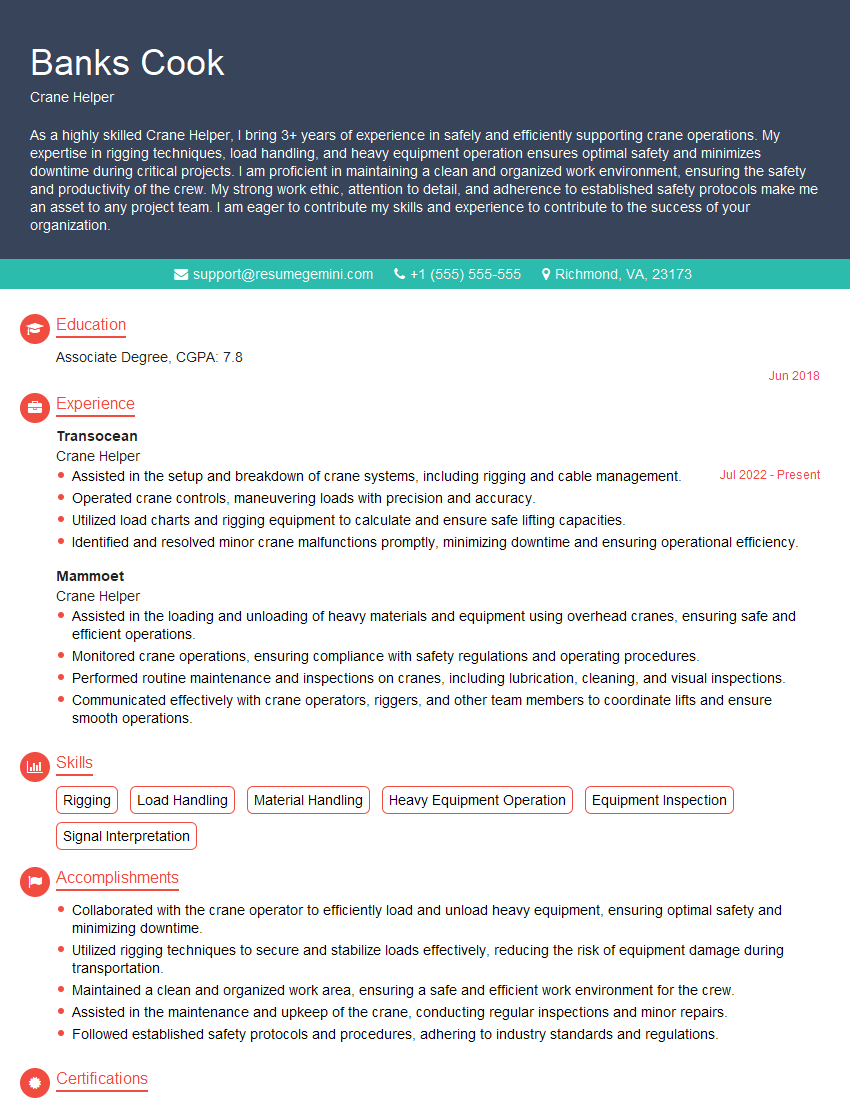Are you a seasoned Crane Helper seeking a new career path? Discover our professionally built Crane Helper Resume Template. This time-saving tool provides a solid foundation for your job search. Simply click “Edit Resume” to customize it with your unique experiences and achievements. Customize fonts and colors to match your personal style and increase your chances of landing your dream job. Explore more Resume Templates for additional options.

Banks Cook
Crane Helper
Summary
As a highly skilled Crane Helper, I bring 3+ years of experience in safely and efficiently supporting crane operations. My expertise in rigging techniques, load handling, and heavy equipment operation ensures optimal safety and minimizes downtime during critical projects. I am proficient in maintaining a clean and organized work environment, ensuring the safety and productivity of the crew. My strong work ethic, attention to detail, and adherence to established safety protocols make me an asset to any project team. I am eager to contribute my skills and experience to contribute to the success of your organization.
Education
Associate Degree
June 2018
Skills
- Rigging
- Load Handling
- Material Handling
- Heavy Equipment Operation
- Equipment Inspection
- Signal Interpretation
Work Experience
Crane Helper
- Assisted in the setup and breakdown of crane systems, including rigging and cable management.
- Operated crane controls, maneuvering loads with precision and accuracy.
- Utilized load charts and rigging equipment to calculate and ensure safe lifting capacities.
- Identified and resolved minor crane malfunctions promptly, minimizing downtime and ensuring operational efficiency.
Crane Helper
- Assisted in the loading and unloading of heavy materials and equipment using overhead cranes, ensuring safe and efficient operations.
- Monitored crane operations, ensuring compliance with safety regulations and operating procedures.
- Performed routine maintenance and inspections on cranes, including lubrication, cleaning, and visual inspections.
- Communicated effectively with crane operators, riggers, and other team members to coordinate lifts and ensure smooth operations.
Accomplishments
- Collaborated with the crane operator to efficiently load and unload heavy equipment, ensuring optimal safety and minimizing downtime.
- Utilized rigging techniques to secure and stabilize loads effectively, reducing the risk of equipment damage during transportation.
- Maintained a clean and organized work area, ensuring a safe and efficient work environment for the crew.
- Assisted in the maintenance and upkeep of the crane, conducting regular inspections and minor repairs.
- Followed established safety protocols and procedures, adhering to industry standards and regulations.
Certificates
- Crane Operator Certification
- Signalperson Certification
- First Aid and CPR Certification
- OSHA Safety Certification
Languages
- English
- French
- German
Career Expert Tips:
- Select the ideal resume template to showcase your professional experience effectively.
- Master the art of resume writing to highlight your unique qualifications and achievements.
- Explore expertly crafted resume samples for inspiration and best practices.
- Build your best resume for free this new year with ResumeGemini. Enjoy exclusive discounts on ATS optimized resume templates.
How To Write Resume For Crane Helper
- Highlight your experience in rigging, load handling, and heavy equipment operation.
- Quantify your accomplishments with specific metrics to demonstrate your impact.
- Showcase your commitment to safety by emphasizing your adherence to industry standards and regulations.
- Tailor your resume to the specific requirements of each job you apply for, highlighting the skills and experience that are most relevant.
Essential Experience Highlights for a Strong Crane Helper Resume
- Collaborate with crane operators to ensure efficient loading and unloading of heavy equipment, maintaining optimal safety and minimizing downtime.
- Effectively secure and stabilize loads using rigging techniques, reducing the risk of equipment damage during transportation.
- Maintain a clean and organized work area, ensuring a safe and efficient work environment for the crew.
- Assist in the maintenance and upkeep of the crane, conducting regular inspections and minor repairs.
- Follow established safety protocols and procedures, adhering to industry standards and regulations.
- Contribute to the continuous improvement of crane operations by providing feedback and suggestions.
- Keep abreast of advancements in crane technology and safety best practices through training and research.
Frequently Asked Questions (FAQ’s) For Crane Helper
What are the primary responsibilities of a Crane Helper?
Crane Helpers support crane operators by ensuring the safe and efficient loading, unloading, and transportation of heavy equipment. They use rigging techniques to secure loads, maintain a clean work area, assist with crane maintenance, and adhere to established safety protocols.
What qualifications are typically required to become a Crane Helper?
Crane Helpers typically need a high school diploma or equivalent and may require specific certifications or training in rigging, load handling, or crane operation. Some employers may prefer candidates with experience in construction, transportation, or related fields.
What are the career advancement opportunities for Crane Helpers?
With experience and additional training, Crane Helpers can advance to positions such as Crane Operator, Rigging Supervisor, or Construction Foreman. They may also specialize in specific areas of crane operation, such as offshore or tower cranes.
What is the work environment of a Crane Helper like?
Crane Helpers typically work outdoors in construction sites, industrial facilities, or other locations where cranes are used. They may work in various weather conditions and may be required to lift heavy objects or work at heights.
What are the safety precautions that Crane Helpers must follow?
Crane Helpers must adhere to strict safety protocols, including wearing appropriate safety gear, following load capacity guidelines, and maintaining a safe distance from moving equipment. They must also be aware of potential hazards and take measures to mitigate risks.